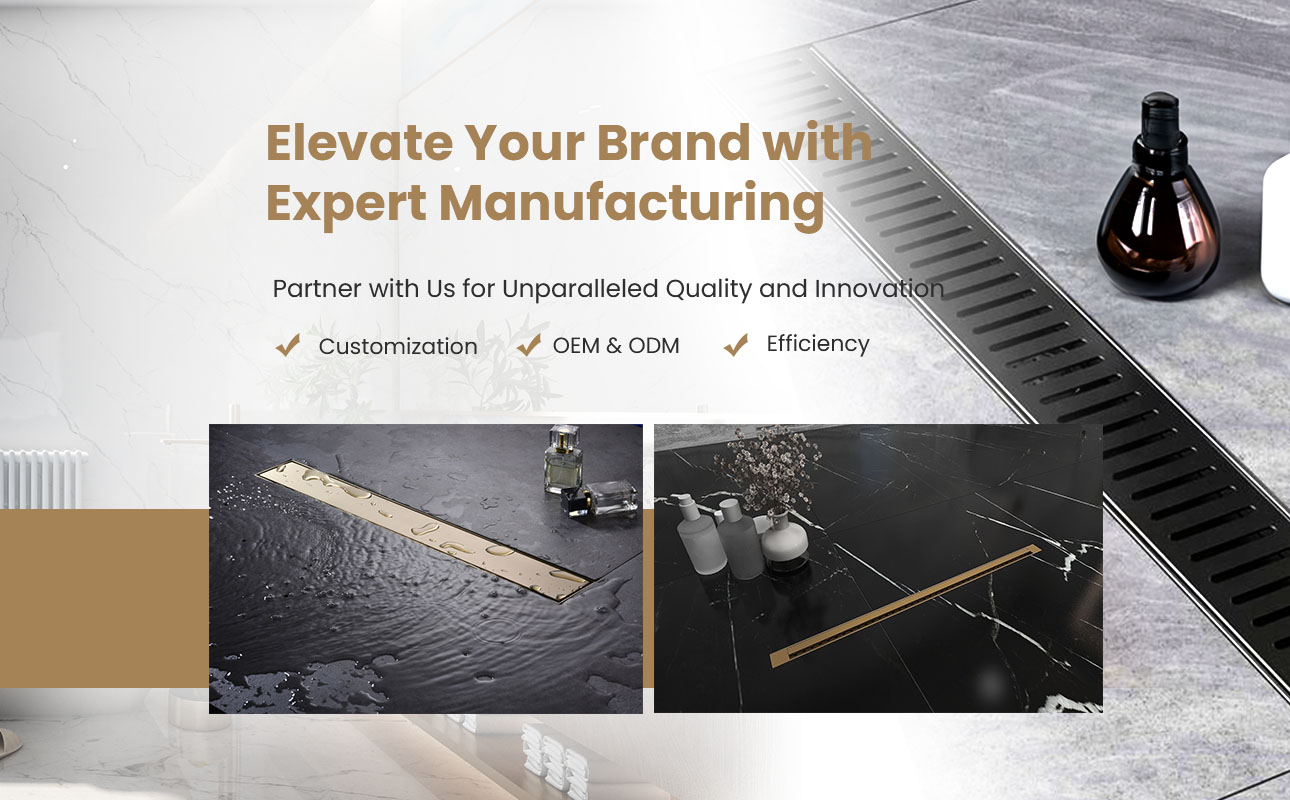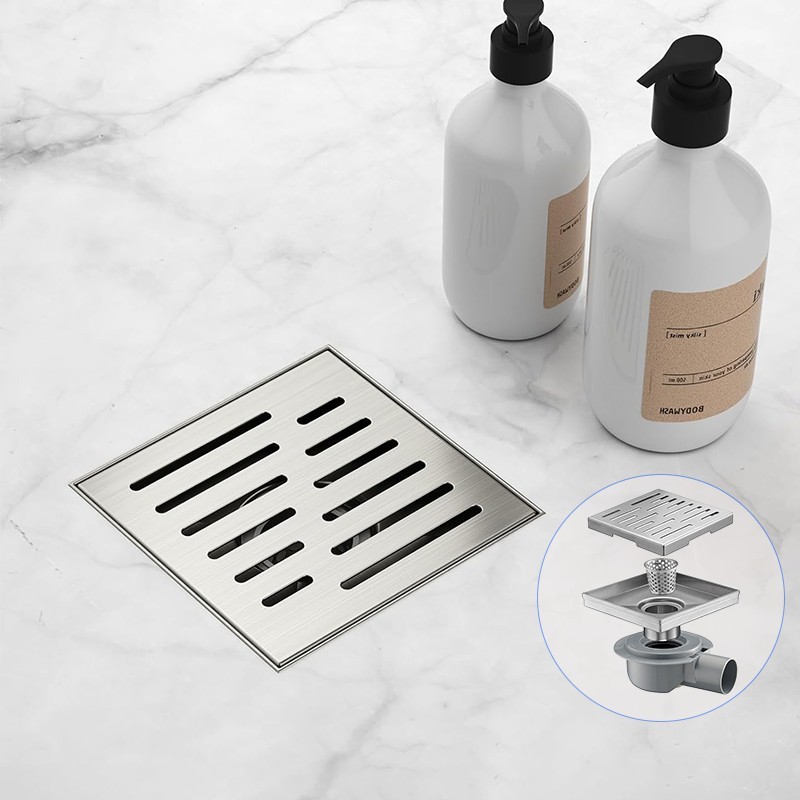Shower Drain Design Trends
Modern Shower Drain design has evolved far beyond basic plumbing. Once hidden beneath the tiles, drains are now essential architectural elements that influence both bathroom aesthetics and functionality. As homes and hotels prioritize minimalism, hygiene, and accessibility, shower drains have become refined design features that merge performance with style. Below are the leading design trends shaping contemporary bathrooms.
1. Rise of Linear and Channel Drains
Traditional round center drains are being replaced by linear or channel-style drains. Unlike small circular outlets that require four-way sloping, Linear Drains only need a single gradient. This allows for larger floor tiles, cleaner lines, and barrier-free designs.
Architects favor linear drains because they integrate seamlessly into open-concept showers and create a sense of spaciousness. Positioned against the wall or threshold, they make water flow direction predictable and easier to manage. The elongated format also complements modern rectangular tile layouts and stone slabs.
A key advantage is their flexibility: linear drains come in different lengths and can be cut to fit custom showers. Many new builds now adopt this format not only for its performance but for its sleek, minimalist aesthetic.
2. Tile-In and Invisible Drain Concepts
The tile-in drain—also called an invisible or hidden drain—represents the next level of minimalist design. Instead of a visible metal grate, a piece of matching tile or stone fits into the drain cover, concealing it completely. The result is a continuous floor surface that emphasizes material uniformity and calm design.
This approach aligns with the growing trend of “quiet luxury” bathrooms, where technical components are visually minimized. Tile-in drains are especially popular in spa-style and high-end residential projects. They allow the floor’s material to shine while maintaining the necessary drainage function.
Because this design relies on precision alignment, installation must ensure exact tile thickness and slope control. Manufacturers now produce adjustable-height frames and easy-to-remove inserts to simplify both installation and cleaning.
3. Finishes and Materials: Beyond Silver Chrome
Stainless steel remains the most popular drain material due to its corrosion resistance and hygiene. However, finish diversity has expanded significantly. Designers now favor tones that coordinate with faucets and hardware:
Matte black drains pair beautifully with concrete or marble floors.
Brushed nickel and gunmetal gray add industrial refinement.
Champagne gold or rose bronze complements warm-tone interiors.
These finishes are often applied through PVD (Physical Vapor Deposition), ensuring long-lasting color stability. Modern bathrooms are moving away from standard chrome toward finishes that express individuality.
In addition, Grade 304 or 316 stainless steel remains a benchmark for durability, ensuring long-term resistance to moisture and cleaning agents. This combination of advanced coating technology and premium metal construction keeps drains looking new for years.
4. Barrier-Free and Walk-In Shower Design
The global shift toward curbless and accessible bathrooms has had a major influence on drain design. Linear drains make it easier to eliminate thresholds and integrate shower floors with the rest of the space. The single-slope floor required by linear drains simplifies water management while maintaining a flush transition.
Barrier-free showers not only look elegant but are practical for users of all ages. With seamless flooring, the bathroom feels more open and safer to enter. Drainage systems with high flow capacity are essential in these installations, ensuring quick water removal even in open layouts.
This trend merges function with inclusivity, showing how thoughtful drainage contributes directly to universal bathroom design.
5. Minimalism and Geometric Simplicity
Modern interiors emphasize clean geometry and visual continuity, and drain grates follow the same principle. Today’s popular grate patterns include narrow linear slots, geometric perforations, or even micro-perforated holes that create texture without drawing attention.
For ultra-minimal bathrooms, frameless edge and zero-profile grates have become a design favorite. These drains are flush with the tile surface, eliminating raised edges or visual interruptions.
By reducing clutter, designers create a sense of calm and balance—one of the defining goals of contemporary bathroom aesthetics.
6. Functional Innovation: High Flow and Easy Cleaning
While appearance matters, performance remains essential. The latest shower drains feature deeper channels, optimized outlet angles, and removable baskets to catch hair and debris. Some models even include silicone seals to reduce odor and prevent insects from entering.
Maintenance is now a key design consideration. Grates that can be lifted easily without tools allow users to clean drains regularly. Anti-splash channels and water-guiding grooves also improve drainage efficiency.
In high-use areas such as hotels or wellness centers, high-flow drains capable of handling up to 60 liters per minute are increasingly common. Function and form are now inseparable—the most successful drain designs combine elegant appearance with long-term practicality.
7. Sustainable and Hygienic Materials
As sustainability becomes central to bathroom design, materials that are recyclable, long-lasting, and easy to maintain are gaining traction. Stainless steel, already known for durability, aligns perfectly with these goals. Its non-porous surface resists bacteria, mold, and chemical corrosion, ensuring hygienic performance.
Some designers are also experimenting with eco-friendly coatings that reduce cleaning frequency or with water channels designed to minimize residue buildup. The focus on low-maintenance materials also reduces reliance on harsh cleaning chemicals, extending product life while lowering environmental impact.
A sustainable drain is not just one that lasts—it’s one that stays cleaner for longer, supporting a healthier living environment.
8. Integration with Large-Format Tiles and Natural Stone
Large-format tiles and seamless stone floors dominate modern bathroom trends. These materials demand precise drain integration. Traditional round drains often require awkward tile cuts, disrupting visual flow.
Linear drains or tile-in designs align perfectly with oversized slabs, preserving pattern continuity. The drain becomes almost invisible, sitting within the grout line or parallel to the tile seam. This precision-based aesthetic aligns with the trend of “architectural minimalism,” where every detail feels intentional.
Designers increasingly select drains that can be custom-sized to match tile dimensions, ensuring that the lines of the flooring extend uninterrupted across the entire bathroom.
9. Smart and Modular Drainage Concepts
Technology is slowly finding its way into bathroom drainage systems. Some premium designs include modular components that allow customization based on flow capacity, pipe position, and installation type.
Emerging “smart” drains integrate water sensors to detect slow flow or blockages before they become major issues. Although still a niche feature, these systems represent the next step in making bathrooms both efficient and intelligent.
Another innovation is the magnetic grate system, which allows for easy removal during cleaning while maintaining a strong seal during use. This focus on user-friendly maintenance highlights a shift toward functionality that enhances daily life rather than adding complexity.
10. The Aesthetic Future of Shower Drains
Looking ahead, shower drain design is expected to continue merging architecture, engineering, and artistry. Future trends emphasize ultra-thin profiles, customizable finishes, and seamless installation. The goal is to make drains completely integrated into the shower experience—unobtrusive yet indispensable.
Designers will likely experiment more with textures and materials such as brushed bronze, carbon steel, and even composite stone. Integration with underfloor heating and waterproof membranes will further enhance comfort and efficiency.
Ultimately, the shower drain has transformed from a simple necessity into an integral part of bathroom architecture—a detail that defines the entire look and feel of the space.
Conclusion
Today’s shower drains embody the modern design ethos: minimalist, efficient, durable, and beautiful. The evolution from visible fixtures to nearly invisible design elements mirrors the broader shift toward functional elegance in interiors. Whether through linear layouts, tile-in surfaces, or advanced coatings, the shower drain continues to evolve as both a technical solution and a design statement.
In every sense, the contemporary drain reflects how small details—when designed thoughtfully—can elevate the everyday experience of water, space, and comfort.




